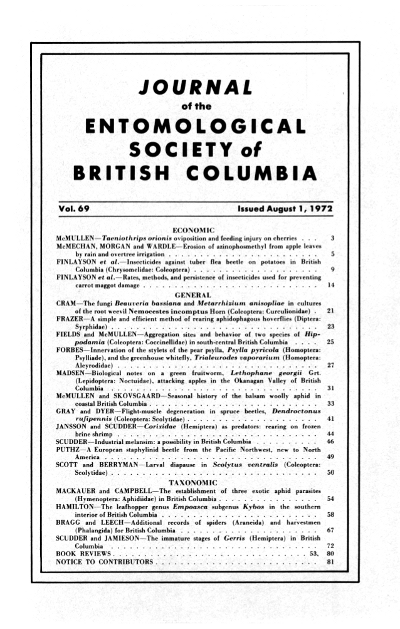Biological notes on a green fruitworm, <i>Lithophane Georgii</i> Grt. (Lepidoptera: Noctuidae), attacking apples in the Okanagan Valley of British Columbia
Keywords:
green fruitworm, <i>Lithophane Georgii</i>, Lepidoptera, NoctuidaeAbstract
For the past 3 seasons, a green fruitworm, <i>Lithophane georgii</i> Grt., has injured apples in the Okanagan Valley of British Columbia. Larvae feed on leaves, will attack fruit early in the season causing deep russeted pits similar to those caused by the fruit-tree leafroller, <i>Archips argyrospilus</i> (Walker). Larvae were active from late April to early June. Pupation took place in the soil, and adults emerged in October. The insect apparently overwinters as an adult and deposits eggs early in the spring, although eggs of this species have not been found in the field. Although larvae of <i>L. georgii</i> are capable of injuring apples, observations in 1970 and 1971 indicate the numbers are so low that the species cannot be considered a major pest.References
Crumb, S.E. 1956. The larvae of the Phalaenidae. U.S. Dept. Agr. Tech. Bull. 1135:186-187.
Rings, Roy W. 1965. Identification of fruitworms and climbing cutworms attacking deciduous fruit trees. Res. Sum. 2. Ohio Agr. Res. and Develop. Cent. pp 47-52.
Rings, Roy W. 1969. Contribution to the bionomics of the green fruitworms: The life history of Lithopane laticinerea. J. Econ. Entomol. 62:1388-1393.
Sanders, C.E., and A.G. Dustan. 1919. The fruit worms of the apple in Nova Scotia. Can. Dept. Agr. Entolmol. Br. Bull. 17:1-28.
Downloads
Published
Issue
Section
License
Authors who publish with the Journal of the Entomological Society of British Columbia agree to the following terms:
-Authors retain copyright and grant the journal right of first publication with the work simultaneously licensed under a Creative Commons Attribution License that allows others to share the work with an acknowledgement of the work's authorship and initial publication in this journal.
-Authors are able to enter into separate, additional contractual arrangements for the non-exclusive distribution of the journal's published version of the work (e.g., post it to an institutional repository or publish it in a book), with an acknowledgement of its initial publication in this journal.
-Authors are permitted and encouraged to post their work online (e.g., in institutional repositories or on their website) prior to and during the submission process, as it can lead to productive exchanges, as well as earlier and greater citation of published work (See The Effect of Open Access).


